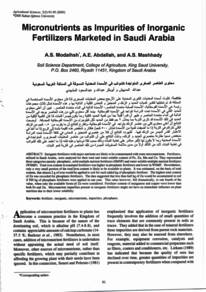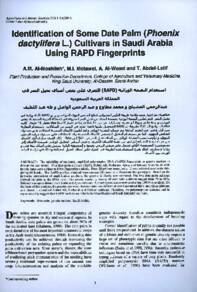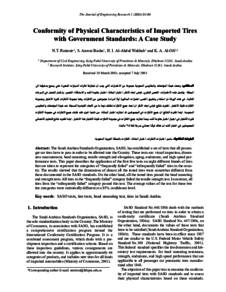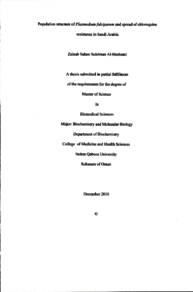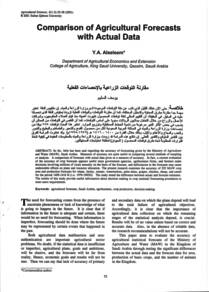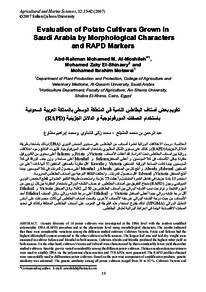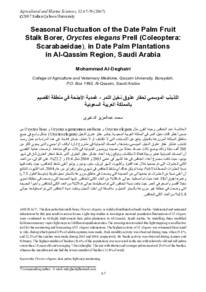Document
Micronutrients as impurities of inorganic fertilizers marketed in Saudi Arabia.
Contributors
Abdallah, A. E., Author
Mashhady, A. S., Author
Publisher
Sultan Qaboos university
Gregorian
2000
Language
English
English abstract
Inorganic fertilizers with major nutrients are likely to be contaminated with some micronutrients. Fertilizers, utilized in Saudi Arabia, were analyzed for their total and water-soluble content of Fe, Zn, Mn and Cu. They represented three categories namely: phosphatic, solid multiple nutrient fertilizers (SMNF) and water-soluble multiple nutrient fertilizers (WSMF). Total iron content in examined fertilizers was higher in phosphatic fertilizers and lower in WSMF. Nevertheless, only a very small portion of the total iron content is likely to be available to plants. It was estimated, on the basis of total content, that almost 2 g of iron would be applied to soil for each added kg of phosphatic fertilizer. The highest total content of Zn was recorded for phosphatic fertilizers. The data suggested that less than half kg of Zn would be accumulated in soil if 500 kg of phosphatic fertilizers were applied in one year. This value however, fell dramatically, to one fourth of the value, when only the available forms of Zn were considered. Fertilizer content of manganese and copper were lower than both Fe and Zn. Micronutrient impurities present in inorganic fertilizers might not have an immediate influence on plant nutrition due to their lower solubility.
Member of
ISSN
2410-1079
Resource URL
Citation
Modaihsh, A. S., Abdallah, A. E., & Mashhady, A. S. (2000). Micronutrients as impurities of inorganic fertilizers marketed in Saudi Arabia. Journal of Agricultural and Marian Sciences, 5 (2), 91-95.
Arabic abstract
تتلوث أسمدة المغذيات الكبرى المعدنية على الأرجح ببعض المغذيات الصغرى لذا فان محتوى الأسمدة المستخدمة في المملكة قد تم تحليلها لتقدير كميات الحديد والزنك والمنجنيز والنحاس الكلية والذائبة بها وهذه الأسمدة تمثل ثلاث مجموعات رئيسة هي الأسمدة الفوسفاتية، الأسمدة الصلبة متعددة العناصر، الأسمدة الذائبة في الماء متعددة العناصر. تبين أن أعلى محتوى الحديد الكلي في الأسمدة تحت الدراسة تتواجد في الأسمدة الفوسفاتية بينما أقل محتوى كلي من هذه العناصر يوجد في الأسمدة الذائبة في الماء متعددة العناصر وظهر أن قدرا قليلا جدا من كمية الحديد الكلية ربما يكون ميسرا للنبات لذا فان الكمية الكلية من الحديد في تلك الأسمدة قد تثري التربة بما يعادل 2 جم فقط من الحديد لكل كيلو جرام من الأسمدة الفوسفاتية المضافة. أوضحت النتائج أن أعلى محتوي كلي من عنصر الزنك يتواجد في الأسمدة الفوسفاتية، وتقترح النتائج أن ما يقرب من 0,5 كجم من الزنك الكلي تتراكم في التربة إذا ما أضيفت كمية من الأسمدة تعادل 500 كجم / هكتار وتنخفض هذه القيمة بشدة إلى الربع إذا ما أخذ في الاعتبار القدر الميسر من الزنك فيها. أظهرت النتائج أن كلا من عنصري المنجنيز والنحاس في كافة الأسمدة تحت الدراسة منخفض نسبيا مقارنة بعنصري الحديد والزنك، ودلت النتائج على أن الشوائب من عناصر المغذيات الصغرى والمتواجدة في الأسمدة المعدنية ربما لا يكون لها تأثير مباشر على تغذية النبات وذلك بسبب قلة ذوبانها وعليه فانه إذا ما اعتمد على تلك الشوائب في تغذية النبات لابد من التأكد أولا من مدى ملائمة المستويات الميسرة من تلك العناصر في التربة لنمو النبات.
Category
Journal articles

